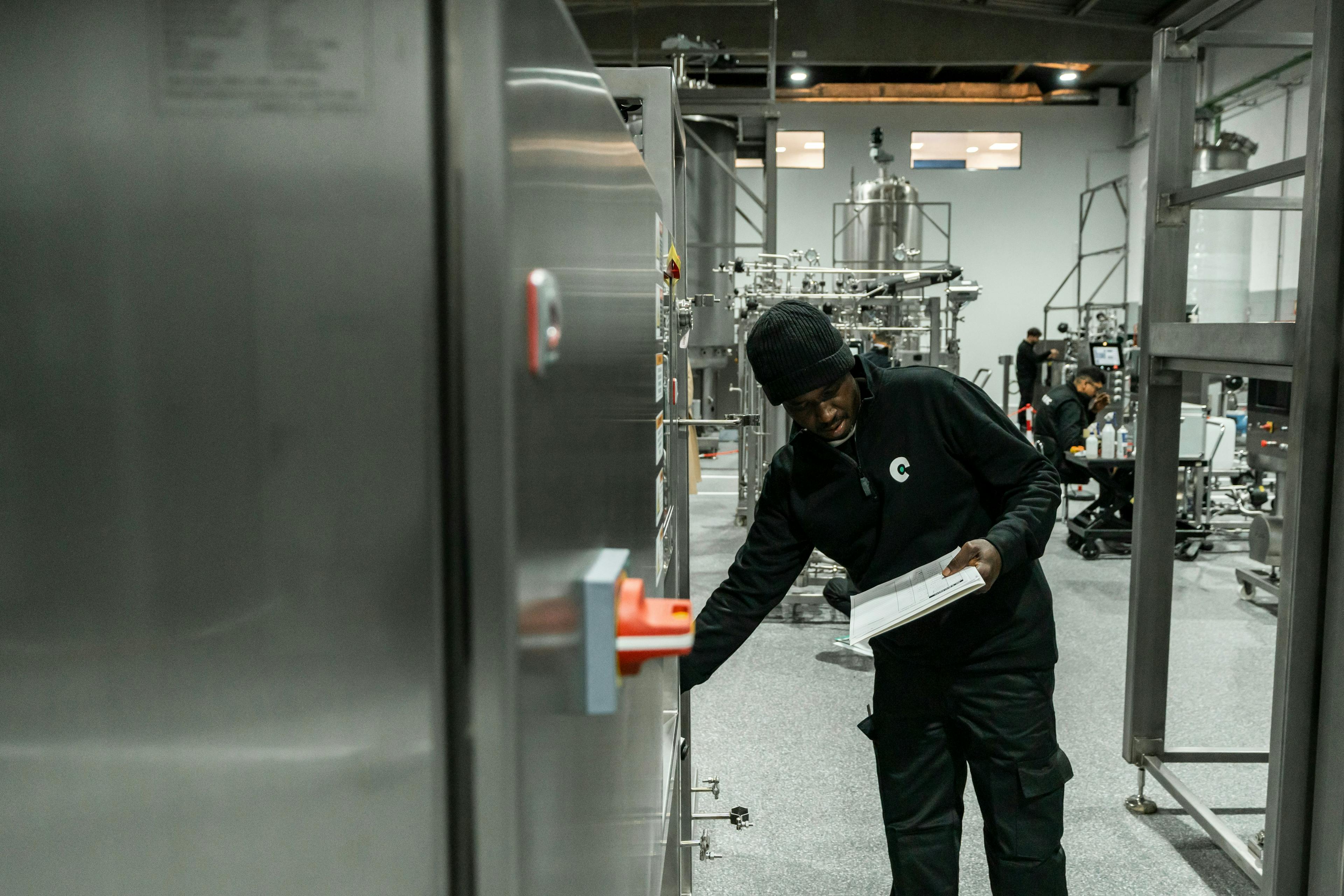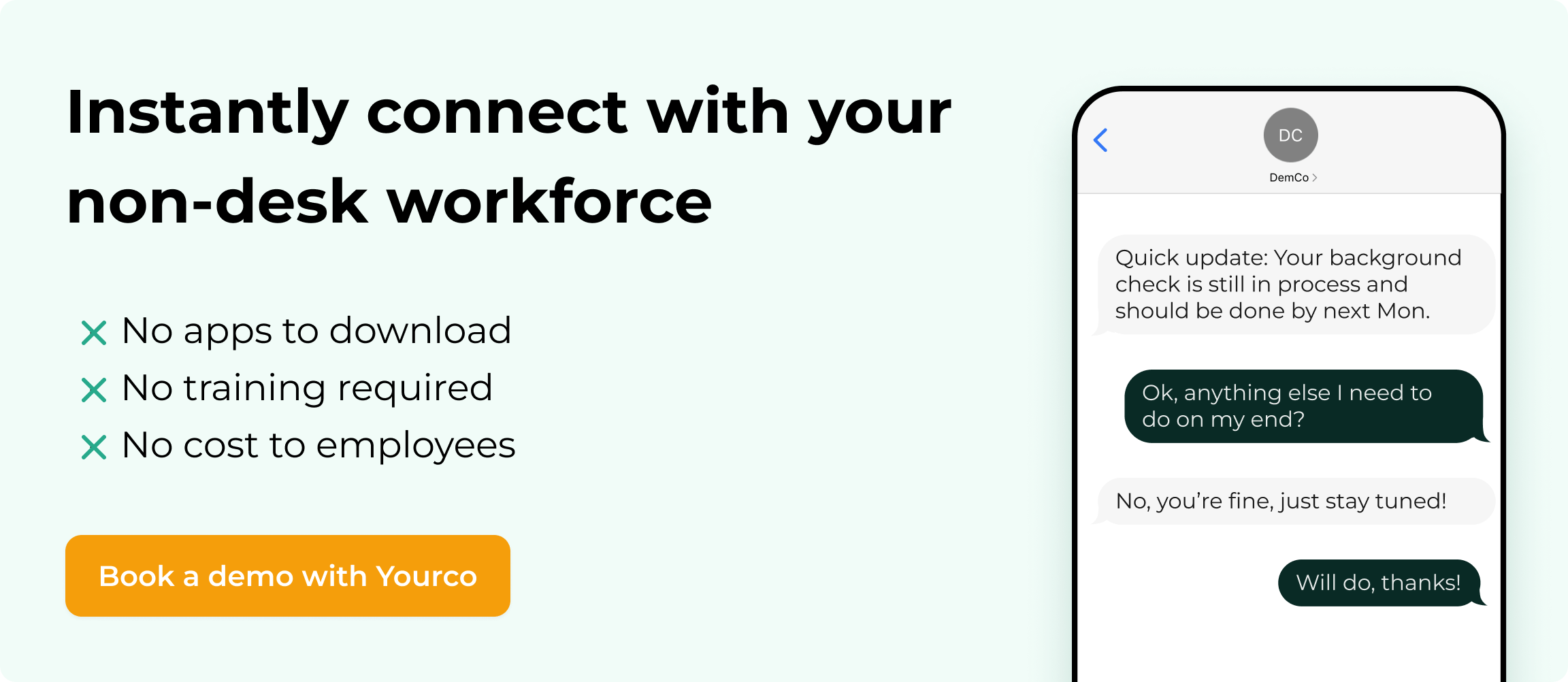Step-by-Step Deployment Guide for Your Task System


Operations managers face a mounting crisis of information overload and change fatigue, as employees receive scattered communications from multiple sources that they often ignore or misunderstand. This communication breakdown doesn't just frustrate managers; it directly impacts productivity, safety, and bottom-line results. Implementing a structured task system could solve these challenges and assist in managing scheduling issues.
A solution exists in plain sight: a task system that provides structured work organization, giving workers clear expectations while maintaining their autonomy. This approach offers measurable outcomes for managers and flexibility for workers, emphasizing completed deliverables rather than hours logged.
This guide covers everything from implementing a task system in five simple steps to measuring success through key performance indicators, and preparing for AI-powered future trends that will reshape how we coordinate distributed teams.
Why Task Systems Boost Deskless-Team Performance
Deskless workers face unique communication challenges that traditional management approaches often fail to address. Unlike their office-based counterparts, these employees juggle assignments across multiple locations, work with limited access to digital platforms, and frequently miss critical updates buried in email chains or lengthy announcements. Information overload and change fatigue compound these issues, leaving operations managers struggling to maintain consistent communication with their distributed teams.
A structured task system transforms this dynamic completely. Workers receive specific, actionable instructions rather than vague directives, naturally increasing productivity. You eliminate the guesswork that typically slows down field operations, construction crews, and retail staff. Employees can focus their energy on execution rather than interpretation instead of seeking clarification from busy supervisors.
This clarity creates genuine autonomy for deskless teams. Workers gain confidence to make decisions and manage their time when they understand exactly what success looks like for each assignment. Rather than waiting for constant guidance, they can prioritize work, adjust their approach based on field conditions, and take ownership of outcomes. This self-direction provides especially valuable benefits for teams spread across multiple job sites or retail locations.
Well-defined completion criteria strengthen accountability through measurable standards. When both workers and managers can assess performance objectively, conflicts decrease and trust increases.
The structured approach dramatically reduces micromanagement needs. Supervisors can focus on strategic oversight rather than constant check-ins when they can easily track progress using SMS-based notification systems, with text messages achieving a 98% read rate compared to emails that often go unnoticed by busy field workers.
For multi-location operations, these systems provide consistent management approaches across different sites. You can standardize processes, compare performance metrics, and share best practices between locations without requiring complex coordination meetings or lengthy status reports.
Readiness Checklist: Prerequisites Before You Roll Out a Task System
Before launching a structured task system for your team, you need to address several critical prerequisites that determine success or failure.
Leadership buy-in ensures your system gets the support and resources it needs. Secure commitment from decision-makers by presenting clear ROI projections and addressing their concerns about implementation costs. Without leadership backing, your system will lack the authority needed to drive adoption across multiple locations. Think of it as getting the green light before you build the highway.
Clear completion criteria eliminate ambiguity about when work is truly finished. Define measurable standards for each assignment type, whether it's "all safety checks completed and documented" or "customer signature obtained." Vague completion criteria lead to disputes and inconsistent work quality. Everyone should know exactly what "done" looks like before they start.
Single communication channels prevent the fragmented messaging that currently plagues operations managers dealing with employees and can help reduce schedule conflicts. Choose one primary method for assignment-related communications rather than mixing emails, texts, and verbal instructions that create confusion. Your teams shouldn't need a decoder ring to figure out where their assignments are coming from.
Baseline metrics establish your starting point for measuring improvement. Track current completion rates, average resolution times, and error frequencies before implementation. Without baseline data, you can't prove your system's effectiveness or identify areas needing adjustment. You need to know where you are before you can celebrate where you're going.
Worker input loops create channels for feedback from the people who'll actually use your system. Employees value transparency and direct communication, so involve them in design decisions. Their insights about daily workflow challenges often reveal critical requirements that managers overlook. The folks doing the work usually know best how to make it work better.
Step-by-Step Deployment Guide for Your Task System
Successfully deploying a structured task system for your employees requires careful planning and methodical execution. This proven five-step approach helps you move from concept to full implementation while avoiding common pitfalls that derail rollouts.
Step 1 – Task Mapping & Standard Setting
Start by identifying and cataloging all recurring activities your teams perform. Walk through each job role and document the specific tasks that happen daily, weekly, and monthly. Focus on assignments that currently cause confusion, delays, or inconsistent results across your workforce.
For each assignment you identify, establish crystal-clear completion criteria. Instead of vague instructions like "clean the equipment," specify exactly what "done" looks like: "Wipe down all surfaces with approved cleaner, check fluid levels, and photograph serial number tag." This precision eliminates guesswork and ensures consistent quality across all team members.
Create assignment categories based on urgency, complexity, and required skills. Simple activities like safety checks can be assigned broadly, while specialized maintenance might require specific certifications. Regularly adjust assignment rates weekly based on output.
Step 2 – Tool Selection & Configuration
Choose your primary communication channel thoughtfully. This will be the backbone of your task system. For many organizations in non-desk industries, SMS remains the most reliable option thanks to its 98% read rate and universal accessibility across all mobile devices. It doesn’t require apps, passwords, or Wi-Fi access, making it ideal for teams with varying levels of tech access or connectivity constraints.
However, depending on your workforce’s needs and digital maturity, you may also consider integrating other channels like Slack, Microsoft Teams, or other dedicated workforce communication platforms. The key is selecting a platform that delivers clarity, consistency, and ease of use.
Once you've selected the right tool:
- Configure assignment workflows: Set up automated scheduling for recurring tasks, escalation rules for missed deadlines, and templates that standardize communication across teams.
- Support language and accessibility needs: If you manage multilingual teams, leverage built-in translation features or multilingual templates to ensure instructions are understood by all employees
- Test across real-world scenarios: Make sure the system performs well across different device types, internet conditions, and geographic locations. This is especially critical for hybrid teams operating across job sites, remote environments, and office settings.
By aligning your communication tools with how your employees actually work—and ensuring those tools are configured for clarity and accountability—you lay the foundation for a task system that scales effectively across your entire organization.
Step 3 – Template Creation & Scheduling
Develop standardized message templates for each assignment type. Effective templates include the description, completion deadline, specific requirements, and clear instructions for confirming completion. Keep messages concise but comprehensive; most workers will read them quickly between other activities.
Build escalation rules into your system from the start. If a worker doesn't acknowledge an assignment within a specified timeframe, the system should automatically notify their supervisor. For critical safety-related activities, consider shorter escalation windows and multiple notification attempts.
Create scheduling templates that account for your operational rhythm. Morning assignments might include safety briefings and equipment checks, while end-of-shift work focuses on reporting and securing work areas. Research shows that poor personalization remains a major barrier to effective workplace communication, so tailor your scheduling to match how your teams actually work.
Step 4 – Training & Change Management
Address the human side of implementation with targeted training programs. Use micro-learning approaches that teach workers one aspect of the system at a time rather than overwhelming them with comprehensive training sessions.
Identify peer champions within each team who can provide ongoing support and encouragement. These informal leaders often have more credibility with their colleagues than formal supervisors and can help address resistance or confusion as it arises.
Additionally, most non-desk workers learn best through hands-on practice, so provide plenty of opportunities to use the system in low-stakes situations.
Be prepared to overcome change fatigue. Communicate clearly about why you're implementing the new task system, how it will benefit workers personally, and what support is available during the transition period.
Step 5 – Launch, Review, Improve
Begin with a phased rollout rather than organization-wide deployment. Start with one team or location where you have strong leadership support and engaged workers. This pilot approach allows you to identify and resolve issues before they affect your entire operation.
Monitor key metrics from day one, including message delivery rates, response times, and completion percentages. Set up regular review sessions with both managers and frontline workers to gather feedback and identify improvement opportunities. Multi-location organizations particularly benefit from systematic monitoring approaches that ensure consistent performance across different sites.
Create a continuous improvement loop that incorporates lessons learned from daily operations. Schedule monthly reviews to assess system performance, update definitions based on real-world experience, and refine your templates based on user feedback. Remember that even the most carefully planned task system will require adjustments as you learn how it performs in actual working conditions.
The most successful implementations remain flexible and responsive to user needs while maintaining the structure and accountability that drive improved performance across your non-desk workforce.
Metrics & KPIs: Proving Your Task System Works
You need concrete data to demonstrate that your structured task system delivers real results. Without proper measurement, you're flying blind when it comes to understanding whether your investment in work management pays off. A solid measurement framework helps you identify what works, spot improvement areas, and make data-driven decisions about your operations.
Core Metrics form the foundation of your measurement strategy. These operational indicators directly reflect how well your system functions day-to-day. Start by tracking your completion rate, which shows the percentage of assigned activities finished within specified timeframes. Average resolution time measures duration from assignment to completion, helping you identify bottlenecks and optimize workflows. Error rate tracking captures quality issues by monitoring work that requires rework or correction, giving you insight into training needs and process clarity.
Engagement Metrics reveal how actively your team participates in the system. Track how quickly workers acknowledge assignments and provide status updates. Feedback scores measure worker satisfaction with clarity, tool usability, and overall effectiveness through simple rating prompts. Voluntary suggestions indicate deeper engagement levels when workers proactively share improvement ideas or report issues without prompting.
Advanced tracking becomes manageable with the right dashboard system. Yourco's analytics platform consolidates these metrics into visual dashboards that update in real-time, allowing you to spot trends quickly. The system tracks response patterns, completion rates across different locations, and performance variations by assignment type or worker group. Data export capabilities let you pull information into Excel for deeper analysis or executive reporting.
The most successful implementations establish baseline measurements before system launch, then track improvements monthly. This approach helps you demonstrate ROI through concrete improvements in efficiency, communication response times, and overall operational performance. The goal isn't perfect scores across all metrics, but rather consistent improvement and early identification of issues before they impact your operations.
The Future of Task Systems
Artificial intelligence is changing how you coordinate and optimize work for non-desk teams. AI-powered analytics are transforming SMS-based workflows by introducing intelligent automation that learns from your team's patterns and preferences. These systems personalize assignments based on individual worker skills, location proximity, and historical performance data, ensuring the right person gets the right work at the optimal time.
Predictive capabilities represent the next major advancement, allowing managers to spot bottlenecks before they happen. These intelligent systems forecast potential issues like equipment failures, staffing shortages, or seasonal demand spikes by analyzing completion patterns and external factors. This proactive approach means you address problems before they impact productivity, keeping operations running smoothly across multiple locations.
Smart automation also streamlines communication through AI-powered chatbots that handle routine queries via SMS. These systems instantly answer questions about procedures, confirm completions, and escalate complex issues to human supervisors when needed. For non-desk workers who need quick answers while in the field, automated text messaging eliminates delays and keeps work flowing.
Yourco leads this evolution with advanced features like automatic language translation, enabling seamless communication across diverse workforces. The platform's predictive analytics help identify optimal assignment patterns while learning from your team's unique workflows to continually enhance workflows over time.
Beyond AI, Yourco offers a full suite of tools to support enterprise-grade coordination. With native integrations into over 240 HRIS and payroll systems, Yourco syncs employee data in real-time, making large-scale task automation seamless and compliant. Role-based access controls ensure that only authorized managers can view or message their teams, and enterprise security features—like passwordless authentication and locked file sharing—protect sensitive information at every step.
The platform’s two-way SMS system supports over 135 languages and includes built-in polls, document sharing, and shift scheduling tools. Yourco’s incident reporting capabilities let workers submit photos or updates in real time, while its analytics dashboards track workforce performance across multiple sites, offering insights into absenteeism trends, task completion rates, and engagement patterns
The core principle remains unchanged: clear expectations paired with autonomy once work is complete. Today's AI-enhanced systems simply make that concept more precise and effective than ever before. Yourco ensures that as your operations scale, your communication and coordination systems scale with them; reliably, securely, and intelligently.
Try Yourco for free today or schedule a demo and see the difference the right workplace communication solution can make in your company.
Frequently Asked Questions
Q: How does SMS communication improve employee engagement compared to email?
SMS messages have a 98% read rate compared to email's much lower engagement metrics. For non-desk workers who don't sit at computers all day, text messages are more accessible and immediate. They don't require internet connectivity or app downloads, making them perfect for field workers, retail staff, or manufacturing teams. Plus, SMS messages are typically brief and focused, delivering only essential information without the clutter that makes emails go unread.
Q: Will implementing a structured task system make my employees feel micromanaged?
Actually, well-designed task systems increase worker autonomy rather than reducing it. By providing clear expectations upfront, you give employees the freedom to complete work their way as long as they meet quality standards. Historical assignment systems worked because they focused on outcomes rather than constant supervision. The key is measuring results, not monitoring every step of the process. Your team will appreciate knowing exactly what success looks like without having someone constantly looking over their shoulder.
Q: How long does it typically take to see results after implementing a task system?
Most organizations notice initial improvements within 2-4 weeks of implementation. Response times and completion rates typically improve first, followed by quality metrics as teams adjust to clearer standards. The key is starting with a phased approach that focuses on high-impact, frequent tasks before expanding to more complex workflows. Establish baseline metrics before you begin so you can measure and celebrate real progress with your team.
Q: What makes Yourco different from other communication platforms for non-desk workers?
Yourco was built specifically for non-desk workers rather than being adapted from office-based systems. The platform combines the universal accessibility of SMS with enterprise-grade security and powerful analytics. Its intuitive interface requires minimal training, which is crucial for diverse workforces with varying levels of technical comfort. Yourco also focuses on structured task coordination rather than just messaging, helping you transform how work gets assigned, tracked, and improved across your organization. The platform's predictive capabilities learn from your team's patterns to continually enhance workflows over time.
Q: How do I convince leadership to invest in a structured task system?
Focus on concrete ROI metrics that matter to your organization. Calculate the current costs of miscommunication, including rework, missed deadlines, and quality issues. Present case studies showing how similar companies improved efficiency after implementation. Emphasize that structured task systems actually reduce management overhead by eliminating constant check-ins and clarifications. Finally, propose a limited pilot with one team to demonstrate value before full-scale implementation, which reduces perceived risk for decision-makers.



